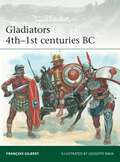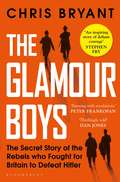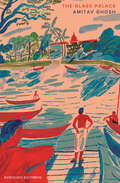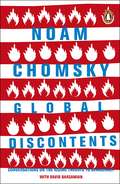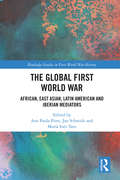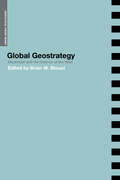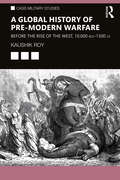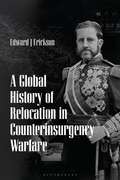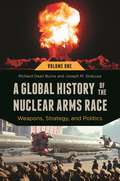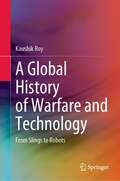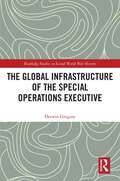- Table View
- List View
Gladiators 4th–1st centuries BC (Elite #246)
by Francois GilbertThis new study lifts the veil on the high-profile but often misunderstood gladiators of ancient Rome, from their origins to the dawn of the Principate.Originating in funeral rites during the Punic Wars of the 3rd century BC, the Roman gladiator games have come to symbolize the spectacle and savagery of Republican and Imperial Rome. Increasingly elaborate rules and rituals governed the conduct of gladiator combat, with an array of specially armed and armoured gladiator types pitted against one another, either singly or in groups. While many gladiators met a grisly end, some survived to achieve celebrity and make huge fortunes.Despite the wealth of literary and archaeological evidence, many misconceptions about the gladiators and their violent world remain. Featuring photographs and drawings of key items of visual evidence and drawing upon the author's wealth of experience and research, this fully illustrated account recreates the little-known and under-represented gladiators of the centuries leading up to the dawn of the Principate, correcting myths and casting new light on the roles, lives and legacy of these legendary arena fighters.
Gladius: Living, Fighting and Dying in the Roman Army
by Guy BédoyèreThe Roman army was the greatest fighting machine the ancient world produced. The Roman Empire depended on soldiers not just to win its wars, defend its frontiers and control the seas but also to act as the engine of the state. Roman legionaries and auxiliaries came from across the Roman world and beyond. They served as tax collectors, policemen, surveyors, civil engineers and, if they survived, in retirement as civic worthies, craftsmen and politicians. Some even rose to become emperors. Gladius takes the reader right into the heart of what it meant to be a part of the Roman army through the words of Roman historians, and those of the men themselves through their religious dedications, tombstones, and even private letters and graffiti. Guy de la Bédoyère throws open a window on how the men, their wives and their children lived, from bleak frontier garrisons to guarding the emperor in Rome, enjoying a ringside seat to history fighting the emperors' wars, mutinying over pay, marching in triumphs, throwing their weight around in city streets, and enjoying esteem in honorable retirement.
The Gladius: The Roman Short Sword (Weapon #51)
by M.C. BishopOne of the most feared weapons in the ancient world, the gladius was lethal both on the battlefield and in the arena. Literary sources tell of the terror it inspired, while archaeological evidence of wounds inflicted is testament to its deadly effect. By pulling together strands of literary, sculptural and archaeological evidence renowned expert M.C. Bishop creates a narrative of the gladius' development, exploring the way in which the shape of the short sword changed as soldiers and gladiators evolved their fighting style.Drawing together historical accounts, excavated artefacts and the results of the latest scientific analyses of the blades, this volume reveals the development, technology, training and use of the gladius hispaniensis: the sword that conquered the Mediterranean.
Gladius: The World of the Roman Soldier
by Guy de la BédoyèreThe Roman army was the greatest fighting machine in the ancient world. More than that, it was the single largest organization in Western antiquity, taking in members from all classes, from senators to freed slaves. The Roman Empire depended on its army not just to win its wars, defend its frontiers, and control the seas, but to act as the very engine of the state. In Gladius, Guy de la Bédoyère takes us straight to the heart of what it meant to be a part of the Roman army. Rather than a history of the army itself, or a guide to military organization and fighting methods, this book is a ground-level recreation of what it was like to be a soldier in the army that made the empire. Surveying numerous aspects of life in the Roman army between 264 BCE and 337 CE, Gladius—the Latin word for sword—draws not only on the words of famed Roman historians, but also those of the soldiers themselves, as recorded in their religious dedications, tombstones, and even private letters and graffiti. Gladius reveals the everyday life of these soldiers and their families, whether stationed in a bleak frontier garrison in Britain or North Africa, tasked with guarding the emperor in Rome, fighting on foreign battlefields, mutinying over pay, marching in triumph, throwing their weight around on city streets, or enjoying esteem in honorable retirement. By illuminating the history of one organization that reflected all corners of the Roman world, Gladius gives us a portrait of an ancient society that is unprecedented in both its broad sweep and gritty intimacy.
The Gladius: The Roman Short Sword (Weapon)
by Peter Dennis M. C. BishopOne of the most feared weapons in the ancient world, the gladius was lethal both on the battlefield and in the arena. Literary sources tell of the terror it inspired, while archaeological evidence of wounds inflicted is testament to its deadly effect. By pulling together strands of literary, sculptural and archaeological evidence renowned expert M.C. Bishop creates a narrative of the gladius' development, exploring the way in which the shape of the short sword changed as soldiers and gladiators evolved their fighting style.Drawing together historical accounts, excavated artefacts and the results of the latest scientific analyses of the blades, this volume reveals the development, technology, training and use of the gladius hispaniensis: the sword that conquered the Mediterranean.
The Glamour Boys: The Secret Story of the Rebels who Fought for Britain to Defeat Hitler
by Chris BryantA STORY OF UNSUNG BRAVERY AT A DEFINING MOMENT IN BRITAIN'S HISTORY'Superb' Stephen Fry'Thrillingly told' Dan Jones'Fascinating' Neil MacGregor'Astonishing' Peter FrankopanWe like to think we know the story of how Britain went to war with Germany in 1939, but there is one chapter that has never been told. In the early 1930s, a group of young, queer British MPs visited Berlin on a series of trips that would change the course of the Second World War. Having witnessed the Nazis' brutality first-hand, these men were some of the first to warn Britain about Hitler, repeatedly speaking out against their government's policy of appeasing him. Prime Minister Neville Chamberlain hated them. Branding them 'the glamour boys' to insinuate something untoward about them, he had their phones tapped and threatened them with deselection and exposure. At a time when even the suggestion of homosexuality could land you in prison, the bravery these men were forced to show in their personal lives gave them extraordinary courage in public. Undaunted, they refused to be silenced and when war came, they enlisted. Four of them died in action. And without them, Britain would never have faced down the Nazis.A Guardian Book of Autumn 2020
The Glamour Boys: The Secret Story of the Rebels who Fought for Britain to Defeat Hitler
by Chris BryantA STORY OF UNSUNG BRAVERY AT A DEFINING MOMENT IN BRITAIN'S HISTORY'Superb' Stephen Fry'Thrillingly told' Dan Jones'Fascinating' Neil MacGregor'Astonishing' Peter FrankopanWe like to think we know the story of how Britain went to war with Germany in 1939, but there is one chapter that has never been told. In the early 1930s, a group of young, queer British MPs visited Berlin on a series of trips that would change the course of the Second World War. Having witnessed the Nazis' brutality first-hand, these men were some of the first to warn Britain about Hitler, repeatedly speaking out against their government's policy of appeasing him. Prime Minister Neville Chamberlain hated them. Branding them 'the glamour boys' to insinuate something untoward about them, he had their phones tapped and threatened them with deselection and exposure. At a time when even the suggestion of homosexuality could land you in prison, the bravery these men were forced to show in their personal lives gave them extraordinary courage in public. Undaunted, they refused to be silenced and when war came, they enlisted. Four of them died in action. And without them, Britain would never have faced down the Nazis.A Guardian Book of Autumn 2020
The Glass Palace
by null Amitav GhoshThe International Bestseller from the Man Booker Prize shortlisted author 'An absorbing story of a world in transition’ JM Coetzee 'A Doctor Zhivago for the Far East' The Independent Rajkumar is only another boy, helping on a market stall in the dusty square outside the royal palace, when the British force the Burmese King, Queen and all the Court into exile. He is rescued by the far-seeing Chinese merchant, and with him builds up a logging business in upper Burma. But haunted by his vision of the Royal Family, he journeys to the obscure town in India where they have been exiled. The story follows the fortunes – rubber estates in Malaya, businesses in Singapore, estates in Burma – which Rajkumar, with his Chinese, British and Burmese relations, friends and associates, builds up – from 1870 through the Second World War to the scattering of the extended family to New York and Thailand, London and Hong Kong in the post-war years.
Global Development: A Cold War History (America in the World #38)
by Sara LorenziniIn the Cold War, "development" was a catchphrase that came to signify progress, modernity, and economic growth. Development aid was closely aligned with the security concerns of the great powers, for whom infrastructure and development projects were ideological tools for conquering hearts and minds around the globe, from Europe and Africa to Asia and Latin America. In this sweeping and incisive book, Sara Lorenzini provides a global history of development, drawing on a wealth of archival evidence to offer a panoramic and multifaceted portrait of a Cold War phenomenon that transformed the modern world.Taking readers from the aftermath of the Second World War to the tearing down of the Berlin Wall, Lorenzini shows how development projects altered local realities, transnational interactions, and even ideas about development itself. She shines new light on the international organizations behind these projects—examining their strategies and priorities and assessing the actual results on the ground—and she also gives voice to the recipients of development aid. Lorenzini shows how the Cold War shaped the global ambitions of development on both sides of the Iron Curtain, and how international organizations promoted an unrealistically harmonious vision of development that did not reflect local and international differences.An unparalleled journey into the political, intellectual, and economic history of the twentieth century, this book presents a global perspective on Cold War development, demonstrating how its impacts are still being felt today.
Global Development: A Cold War History (America in the World #38)
by Sara LorenziniIn the Cold War, "development" was a catchphrase that came to signify progress, modernity, and economic growth. Development aid was closely aligned with the security concerns of the great powers, for whom infrastructure and development projects were ideological tools for conquering hearts and minds around the globe, from Europe and Africa to Asia and Latin America. In this sweeping and incisive book, Sara Lorenzini provides a global history of development, drawing on a wealth of archival evidence to offer a panoramic and multifaceted portrait of a Cold War phenomenon that transformed the modern world.Taking readers from the aftermath of the Second World War to the tearing down of the Berlin Wall, Lorenzini shows how development projects altered local realities, transnational interactions, and even ideas about development itself. She shines new light on the international organizations behind these projects—examining their strategies and priorities and assessing the actual results on the ground—and she also gives voice to the recipients of development aid. Lorenzini shows how the Cold War shaped the global ambitions of development on both sides of the Iron Curtain, and how international organizations promoted an unrealistically harmonious vision of development that did not reflect local and international differences.An unparalleled journey into the political, intellectual, and economic history of the twentieth century, this book presents a global perspective on Cold War development, demonstrating how its impacts are still being felt today.
Global Discontents: Conversations on the Rising Threats to Democracy (American Empire Project Ser.)
by Noam Chomsky David Barsamian'If I were a voter in Britain, I would vote for [Jeremy Corbyn]' - Noam Chomsky, 2017Global Discontents is an essential guide to geopolitics and how to fight back, from the world's leading public intellectualWhat kind of world are we leaving to our grandchildren? How are the discontents kindled today likely to blaze and explode tomorrow?From escalating climate change to the devastation in Syria, pandemic state surveillance to looming nuclear war, Noam Chomsky takes stock of the world today. Over the course of ten conversations with long-time collaborator David Barsamian, spanning 2013-2016, Chomsky argues in favour of radical changes to a system that cannot possibly cope with what awaits tomorrow.Interwoven with personal reflections spanning from childhood to his eighth decade of life, Global Discontents also marks out Chomsky's own intellectual journey, mapping his progress to revolutionary ideas and global prominence.
The Global First World War: African, East Asian, Latin American and Iberian Mediators (Routledge Studies in First World War History)
by Ana Paula Pires; Jan Schmidt; María Inés TatoThis volume deals with the multiple impacts of the First World War on societies from South Europe, Latin America, Asia and Africa, usually largely overlooked by the historiography on the conflict. Due to the lesser intensity of their military involvement in the war (neutrals or latecomers), these countries or regions were considered "peripheral" as a topic of research. However, in the last two decades, the advances of global history recovered their importance as active wartime actors and that of their experiences. This book will reconstruct some experiences and representations of the war that these societies built during and after the conflict from the prism of mediators between the war fought in the battlefields and their homes, as well as the local appropriations and resignifications of their experiences and testimonies.
The Global First World War: African, East Asian, Latin American and Iberian Mediators (Routledge Studies in First World War History)
by Ana Paula Pires María Inés Tato Jan SchmidtThis volume deals with the multiple impacts of the First World War on societies from South Europe, Latin America, Asia and Africa, usually largely overlooked by the historiography on the conflict. Due to the lesser intensity of their military involvement in the war (neutrals or latecomers), these countries or regions were considered "peripheral" as a topic of research. However, in the last two decades, the advances of global history recovered their importance as active wartime actors and that of their experiences. This book will reconstruct some experiences and representations of the war that these societies built during and after the conflict from the prism of mediators between the war fought in the battlefields and their homes, as well as the local appropriations and resignifications of their experiences and testimonies.
Global Geostrategy: Mackinder and the Defence of the West
by Brian W. BlouetThis is a new examination of Halford Mackinder’s seminal global geostrategic work, from the perspective of geography, diplomatic history, political science, international relations, imperial history, and the space age.Mackinder was a man ahead of his time. He foresaw many of the key strategic issues that came to dominate the twentieth century. Until the disintegration of the Soviet Union, western defence strategists feared that one power, or alliance, might come to dominate Eurasia. Admiral Mahan discussed this issue in The Problem of Asia (1900) but Mackinder made the most authoritative statement in "The Geographical Pivot of History" (1904). He argued that in the "closed Heart-Land of Euroasia" was a strategically placed region, with great resources, that if controlled by one force could be the basis of a World Empire. James Kurth, in Foreign Affairs, has commented that it has taken two World Wars and the Cold War to prevent Mackinder’s prophecy becoming reality. In World War I and World War II Germany achieved huge territorial gains at the expense of the Russian empire and the Soviet Union. In the former conflict the Russian empire was defeated by Germany but the western powers insisted that the territorial gains made by Germany, at the treaty of Brest-Litovsk, be given up. In World War II Britain and the US gave material support to Stalin’s totalitarian regime to prevent Nazi Germany gaining control of the territory and resources that might have been a basis for world domination. The west, highly conscious of Mackinder’s dictum (1919) that "Who rules East Europe commands the Heartland," quickly adopted policies to contain the Soviet Union. History has therefore proved Mackinder’s work to be of vital importance to generations of strategic thinking and he remains a key influence in the new millennium.This book will be of great interest to all students and scholars of strategic studies and military history and of geopolitics in particular.
Global Geostrategy: Mackinder and the Defence of the West
This is a new examination of Halford Mackinder’s seminal global geostrategic work, from the perspective of geography, diplomatic history, political science, international relations, imperial history, and the space age.Mackinder was a man ahead of his time. He foresaw many of the key strategic issues that came to dominate the twentieth century. Until the disintegration of the Soviet Union, western defence strategists feared that one power, or alliance, might come to dominate Eurasia. Admiral Mahan discussed this issue in The Problem of Asia (1900) but Mackinder made the most authoritative statement in "The Geographical Pivot of History" (1904). He argued that in the "closed Heart-Land of Euroasia" was a strategically placed region, with great resources, that if controlled by one force could be the basis of a World Empire. James Kurth, in Foreign Affairs, has commented that it has taken two World Wars and the Cold War to prevent Mackinder’s prophecy becoming reality. In World War I and World War II Germany achieved huge territorial gains at the expense of the Russian empire and the Soviet Union. In the former conflict the Russian empire was defeated by Germany but the western powers insisted that the territorial gains made by Germany, at the treaty of Brest-Litovsk, be given up. In World War II Britain and the US gave material support to Stalin’s totalitarian regime to prevent Nazi Germany gaining control of the territory and resources that might have been a basis for world domination. The west, highly conscious of Mackinder’s dictum (1919) that "Who rules East Europe commands the Heartland," quickly adopted policies to contain the Soviet Union. History has therefore proved Mackinder’s work to be of vital importance to generations of strategic thinking and he remains a key influence in the new millennium.This book will be of great interest to all students and scholars of strategic studies and military history and of geopolitics in particular.
A Global History of Pre-Modern Warfare: Before the Rise of the West, 10,000 BCE–1500 CE (Cass Military Studies)
by Kaushik RoyThis book examines the military histories of the regions beyond Western Europe in the pre-modern era. Existing works on global military history mainly focus on the western part of Eurasia after 1500 CE. As regards the ancient period, such works concentrate exclusively on Greece and Rome. So, ‘global’ military history is actually the triumphal story of the West from Classical Greece onwards. This volume focuses not only on the eastern part of Eurasia but also on South America, Africa and Australasia and seeks to explain the history and varied trajectories of warfare in non-Western regions in the pre-modern era. Further, it evaluates whether warfare in non-Western regions should be considered primitive or inferior when compared with Western warfare. The book notes that Western Europe became militarily significant only in the early modern era and argues that the military divergence that occurred during the early modern era is not unique – it had also occurred in the Bronze Age, the Classical era and in the medieval period. This was due to the dynamism and innovativeness of non-Western militaries and the interconnectedness that existed in parts of the Eurasian landmass. Further, those polities which were able to construct a balanced military force by synthesising diverse elements were not only able to survive but also became capable of projecting power across continents. This book will be of much interest to students of military history, strategic studies and world history.
A Global History of Pre-Modern Warfare: Before the Rise of the West, 10,000 BCE–1500 CE (Cass Military Studies)
by Kaushik RoyThis book examines the military histories of the regions beyond Western Europe in the pre-modern era. Existing works on global military history mainly focus on the western part of Eurasia after 1500 CE. As regards the ancient period, such works concentrate exclusively on Greece and Rome. So, ‘global’ military history is actually the triumphal story of the West from Classical Greece onwards. This volume focuses not only on the eastern part of Eurasia but also on South America, Africa and Australasia and seeks to explain the history and varied trajectories of warfare in non-Western regions in the pre-modern era. Further, it evaluates whether warfare in non-Western regions should be considered primitive or inferior when compared with Western warfare. The book notes that Western Europe became militarily significant only in the early modern era and argues that the military divergence that occurred during the early modern era is not unique – it had also occurred in the Bronze Age, the Classical era and in the medieval period. This was due to the dynamism and innovativeness of non-Western militaries and the interconnectedness that existed in parts of the Eurasian landmass. Further, those polities which were able to construct a balanced military force by synthesising diverse elements were not only able to survive but also became capable of projecting power across continents. This book will be of much interest to students of military history, strategic studies and world history.
A Global History of Relocation in Counterinsurgency Warfare
by Edward J. EricksonRelocation as a strategy and operational approach in war has reappeared in various forms from the late 18th century to the present day. In A Global History of Relocation in Counterinsurgency Warfare, Edward J Erickson brings together a distinguished cast of contributors to present a chronological survey of the major relocations of people conducted as deliberate operational approaches to modern conflicts.Each chapter covers a different case study, including the removal of Native Americans in the USA, La Reconcentracion in Cuba, the American internment of Filipinos after the Balangiga Massacre, the deportation of the Boer population in South Africa and the relocation of Ottoman Armenians and Russian Jews. Bringing together the threads of the separate case studies, the conclusion reaffirms relocation as a deliberate operational approach used by major powers in warfare against real or perceived threats. This is a vital volume for academics and students interested in military history, counterinsurgency and strategic studies.
A Global History of Relocation in Counterinsurgency Warfare
Relocation as a strategy and operational approach in war has reappeared in various forms from the late 18th century to the present day. In A Global History of Relocation in Counterinsurgency Warfare, Edward J Erickson brings together a distinguished cast of contributors to present a chronological survey of the major relocations of people conducted as deliberate operational approaches to modern conflicts.Each chapter covers a different case study, including the removal of Native Americans in the USA, La Reconcentracion in Cuba, the American internment of Filipinos after the Balangiga Massacre, the deportation of the Boer population in South Africa and the relocation of Ottoman Armenians and Russian Jews. Bringing together the threads of the separate case studies, the conclusion reaffirms relocation as a deliberate operational approach used by major powers in warfare against real or perceived threats. This is a vital volume for academics and students interested in military history, counterinsurgency and strategic studies.
A Global History of the Nuclear Arms Race [2 volumes]: Weapons, Strategy, and Politics [2 volumes] (Praeger Security International)
by Richard Dean Burns Joseph M. SiracusaWritten by two preeminent authors in the field, this book provides an accessible global narrative of the nuclear arms race since 1945 that focuses on the roles of key scientists, military chiefs, and political leaders.The first book of its kind to provide a global perspective of the arms race, this two-volume work connects episodes worldwide involving nuclear weapons in a comprehensive, narrative fashion. Beginning with a discussion of the scientific research of the 1930s and 1940s and the Hiroshima decision, the authors focus on five basic themes: political dimensions, technological developments, military and diplomatic strategies, and impact.The history of the international nuclear arms race is examined within the context of four historical eras: America's nuclear monopoly, America's nuclear superiority, superpower parity, and the post-Cold War era. Information about the historical development of the independent deterrence of Britain, France, and China, as well as the piecemeal deterrence of newcomers Israel, India, Pakistan, and North Korea is also included, as is coverage of the efforts aimed at the international control of nuclear weapons and the diplomatic architecture that underpins the global nuclear non-proliferation regime.
A Global History of the Nuclear Arms Race [2 volumes]: Weapons, Strategy, and Politics [2 volumes] (Praeger Security International)
by Richard Dean Burns Joseph M. SiracusaWritten by two preeminent authors in the field, this book provides an accessible global narrative of the nuclear arms race since 1945 that focuses on the roles of key scientists, military chiefs, and political leaders.The first book of its kind to provide a global perspective of the arms race, this two-volume work connects episodes worldwide involving nuclear weapons in a comprehensive, narrative fashion. Beginning with a discussion of the scientific research of the 1930s and 1940s and the Hiroshima decision, the authors focus on five basic themes: political dimensions, technological developments, military and diplomatic strategies, and impact.The history of the international nuclear arms race is examined within the context of four historical eras: America's nuclear monopoly, America's nuclear superiority, superpower parity, and the post-Cold War era. Information about the historical development of the independent deterrence of Britain, France, and China, as well as the piecemeal deterrence of newcomers Israel, India, Pakistan, and North Korea is also included, as is coverage of the efforts aimed at the international control of nuclear weapons and the diplomatic architecture that underpins the global nuclear non-proliferation regime.
A Global History of Warfare and Technology: From Slings to Robots
by Kaushik RoyThis book addresses the global history of technology, warfare and state formation from the Stone Age to the Information Age. Using a combination of top-down and bottom-up methodologies, it examines both interstate and intrastate conflicts with a focus on Eurasian technology and warfare. It shows how human agency and structural factors have intertwined, creating a complex web of technology and warfare. It also explores the interplay between technological and non-technological factors to chart the evolution of warfare from its origins to the present day, arguing that the interactions between civilian and military sectors have shaped the use of technology in warfare. Given its scope and depth, it is a valuable resource for researchers in fields such as world history, history of science and technology, history of warfare and imperialism and international relations.
The Global Infrastructure of the Special Operations Executive (Routledge Studies in Second World War History)
by Derwin GregoryDuring the Second World War, the British government established the Special Operations Executive (SOE) for the purpose of coordinating ‘all action, by way of subversion and sabotage, against the enemy overseas’. Although the overseas operations of this branch of the British Secret Services are relatively well known, few studies have explored the ‘backroom sections’ of this organisation. This book draws together the infrastructure developed to support an agent’s ‘journey’ from recruitment to despatch to the field. At the start of the Second World War there were few existing facilities established within the UK to support clandestine operations. As the conflict progressed, in parallel to learning the operational procedures of their trade, SOE also had to rapidly expand their support infrastructure around the world. The organisation could effectively support their agents only by establishing facilities dedicated to training, research and development, supply, transportation, communication, and command and control. By predominately focusing on the organisation’s ‘agent facing’ infrastructure, this book provides a backdrop to the brave men and women who conducted operations abroad. In addition, it gives an overview of the facilities in which SOE’s backroom staff lived and worked. The book will be of interest to students and scholars of archaeology, history and war studies.
The Global Infrastructure of the Special Operations Executive (Routledge Studies in Second World War History)
by Derwin GregoryDuring the Second World War, the British government established the Special Operations Executive (SOE) for the purpose of coordinating ‘all action, by way of subversion and sabotage, against the enemy overseas’. Although the overseas operations of this branch of the British Secret Services are relatively well known, few studies have explored the ‘backroom sections’ of this organisation. This book draws together the infrastructure developed to support an agent’s ‘journey’ from recruitment to despatch to the field. At the start of the Second World War there were few existing facilities established within the UK to support clandestine operations. As the conflict progressed, in parallel to learning the operational procedures of their trade, SOE also had to rapidly expand their support infrastructure around the world. The organisation could effectively support their agents only by establishing facilities dedicated to training, research and development, supply, transportation, communication, and command and control. By predominately focusing on the organisation’s ‘agent facing’ infrastructure, this book provides a backdrop to the brave men and women who conducted operations abroad. In addition, it gives an overview of the facilities in which SOE’s backroom staff lived and worked. The book will be of interest to students and scholars of archaeology, history and war studies.
Global Jihadism: Theory and Practice (Political Violence)
by Jarret M. BrachmanGlobal Jihadism exposes the core doctrine and strategy of today’s global Jihadist movement. The first half of the book explores the ideas upon which groups such as Al Qaeda are built, including the concepts of Jihad, al-Wala wal-Bara, Takfir and Tawhid. Jarret Brachman exposes a genre of Jihadist strategic scholarship that has been virtually ignored in the West and helps to situate it within the broader Salafist religious movement. The second half explores the thinking and activities of Al Qaeda’s propaganda machine, explaining its intricacies and idiosyncrasies. It includes case studies on the rise and fall of global Jihadist terrorism in Saudi Arabia post-9/11, and highlights the explosive results of bringing theory to bear on practice in the United Kingdom over the past twenty years. The book concludes by providing innovative strategies for combating the global Jihadist ideology.
